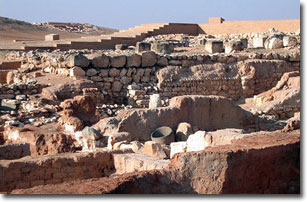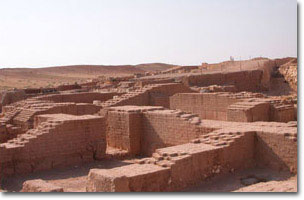|
Ebla (Tell Mardikh): 54 Km away from Aleppo, lies the excavation site that used to be the capital of an ancient kingdom. Ebla the ancient city found at Tell Mardikh is one of the most important Bronze Age sites discovered since the Second World War but it yields few of its secrets to the naked eye.
The history of Ebla and its place in the Bronze Age civilizations of the area is a fascinating piece of historical reconstruction marked by considerable controversy. The discovery in 1975 of a major archive of clay tablets at Ebla should throw much light on the period and the inter-relationships between the kingdoms and city/states of the area but the work of translating and publishing the tablets is making slow progress.
In 1964 an Italian excavation team began to dig here and discovered this Bronze Age city. It reveals a Syrian counterpart to the major centers of Sumer and Akkad in southern Iraq, and north into Anatolia. Not much is known about the people of this kingdom, although it is thought that the founders are of Amorite descent. Their language is known as Eblaic, and it was recorded on clay tablets in the Akkadian cuneiform.
It is clear that Ebla was an important power in northern Syria in the late third and early second millennia, particularly as a trading hub. The considerable agricultural Ebla reached the peak of its prosperity in the period 2400 - 2250 BC, bringing under its control most of the western part of northern Syria and enjoying close relations with Mari to the east.
Syria EblaNot Ebla's days of glory were brought to an end either by Sargon, the first great Akkadian ruler or his grandson, Naram Sin (around 2250 BC). Though the city survived for another 600 years, it never regained its central role. It was sacked around 2000 BC and incorporated into the Kingdom of Yamhad (Aleppo). And then fell to the Hittites around 1600 BC. The last historical mention of Ebla is from 1450 BC when the Egyptian Pharaoh Thutmose III recorded on a monument at Karnak that the Egyptian army marched through this city on its way to the Euphrates.
The remains of Bronze Age tell are of enormous dimensions (50 ha) and only a small fraction has been exposed in the Italian excavations.
The city is circular and surrounded by a 20 to 30 meter thick wall and had an acropolis in the center of it. At four points round the city, the wall was perforated by gateways guarded by bastions with towers. One of these Bronze Age gateways is still evident on the southwest side of the city walls.
The acropolis at the center includes two palaces, the best preserved one is the royal palace on the west side that consists of the royal quarters and an administrative area. Three underground chambers formed of natural caves lay beneath the administrative area and were later (18th century BC) used for burial of royalties during the period 1825 - 1650 BC.
The palace archives were found in the southern part of this palace. North of the tell are the remains of an Amorite fortress, which was found under a villa dating back to the Persian/Hellenistic periods.
An Aramean fortress dating back to the 9th and 8th centuries BC, and other remains from the Persian/ Byzantine show that it was still used, although it had lost its fame and was for the most part an abandoned city.
Note: Most of the artifacts and archives can be found at the Idleb museum.  
|